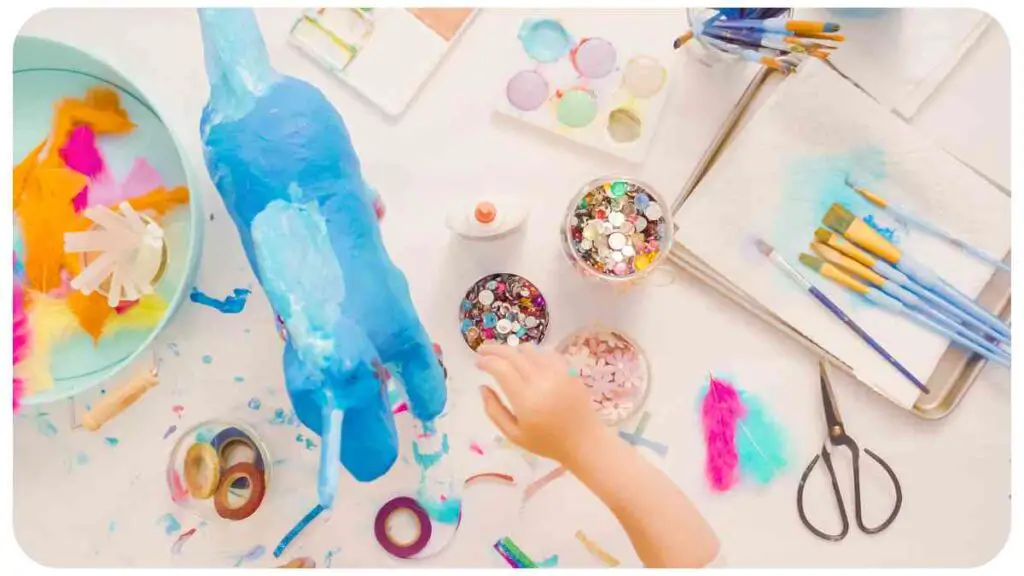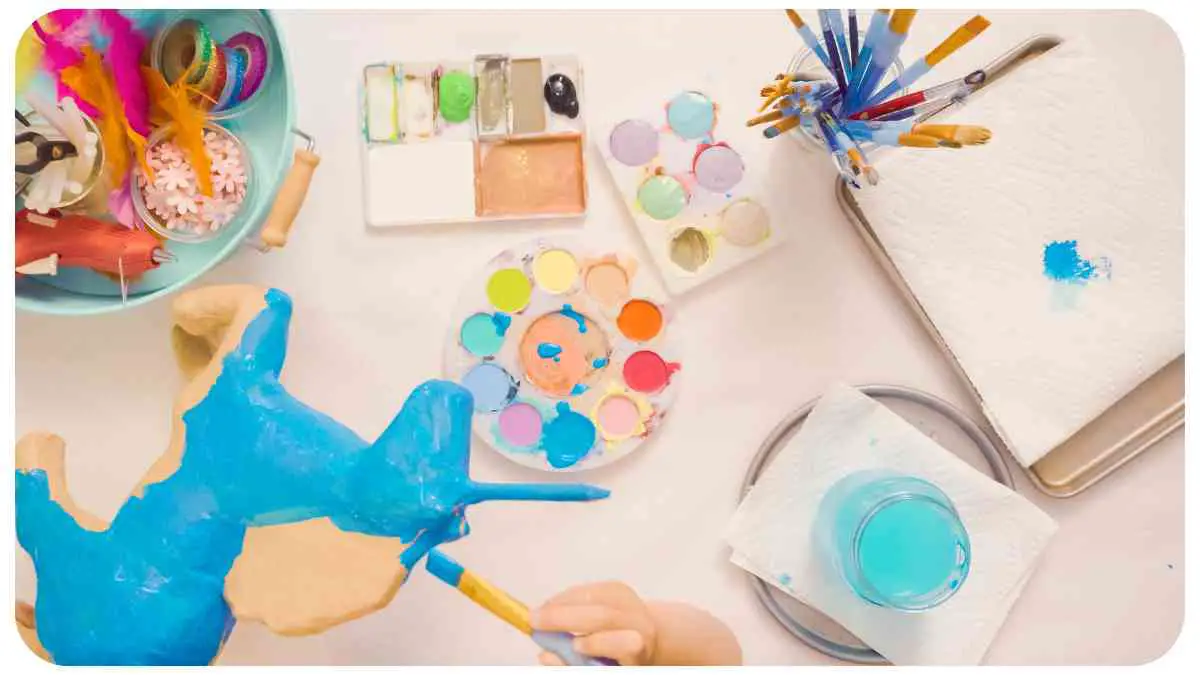Welcome to this comprehensive guide on paper mache and how to fix common problems encountered during art projects. As a professional in this field, my aim is to share my experience, expertise, and insights to help you overcome challenges and create exceptional paper mache artworks.
In this article, you will discover various quick fixes to common paper mache problems, as well as advanced tips for successful projects. So, let’s dive in and explore the world of paper mache!
| Takeaways |
|---|
| Quick Fixes for common paper mache problems |
| Advanced tips for successful paper mache projects |
| Proper prepping and planning are essential for a smooth paper mache experience |
| Choosing high-quality materials can greatly impact the outcome of your project |
| Layering techniques and proper drying are crucial for creating a strong and durable structure |
| Additional resources and further reading can provide valuable insights and techniques to improve your paper mache skills |
| Practice and experimentation will help you master the art of paper mache |
| Enjoy the process and let your creativity shine through your unique paper mache creations |
2. Understanding Paper Mache
2.1 What is Paper Mache?

Paper mache, derived from the French term “papier-mâché,” is a crafting technique that involves using a mixture of paper and adhesive to create objects or sculptures. By layering strips of paper soaked in a paste-like mixture and allowing it to dry, a strong and versatile structure can be formed. This technique is popular among artists, educators, and hobbyists alike due to its affordability and flexibility.
Looking for some inspiration to fuel your creativity? Check out these amazing paper mache projects that will unleash your imagination and help you create something extraordinary for your art projects.
2.2 History of Paper Mache
Paper mache has a rich history dating back thousands of years. It originated in ancient Egypt and China, where it was used to create decorative objects, burial masks, and even armor. Over time, it spread across different cultures and was adapted to various artistic traditions. Today, paper mache continues to captivate with its endless possibilities for creativity and expression.
2.3 Benefits and Uses
The versatility of paper mache makes it suitable for a wide range of projects. Whether you’re crafting masks, piñatas, sculptures, or intricate models, paper mache offers a lightweight and durable solution.
It is an excellent choice for both indoor and outdoor artworks, as it can withstand different environments with proper finishing techniques. Furthermore, paper mache allows for easy customization and can be painted, varnished, or embellished to achieve desired effects.
2.4 Common Mistakes
| Common Mistakes in Paper Mache |
| Using the wrong type of glue |
| Inadequate drying time |
| Applying too many layers without drying in between |
| Using low-quality paper |
| Neglecting to reinforce weak areas |
Table 1: Common Mistakes in Paper Mache
Before delving into the quick fixes, let’s address some common mistakes made during paper mache projects. By avoiding these pitfalls, you can save time and frustration.
3. Quick Fixes for Common Paper Mache Problems
No matter how experienced you are with paper mache, it’s common to encounter a few hiccups along the way. Fortunately, with the right solutions, you can quickly fix these issues and salvage your project. Let’s explore some of the most common problems faced during paper mache projects and their respective quick fixes.
Exploring your passion for crafts doesn’t have to break the bank. Discover a plethora of budget-friendly ideas and get inspired by these incredible inexpensive paper crafts that bring out the artist in you without draining your wallet
3.1 Issue 1: Wrinkles and Bubbles on the Surface
| Solutions for Wrinkles and Bubbles |
| Smooth and flatten the affected area with your fingers or a soft brush while the paper mache is still wet and pliable. |
| Use a pin or needle to gently puncture any air bubbles and press down to remove the excess air. |
| Apply an additional layer of paper mache paste over the affected area and smooth it out with a brush. |
Table 2: Solutions for Wrinkles and Bubbles
Wrinkles and bubbles can occur when the paper mache layers are not applied smoothly or when there is trapped air between the layers. To fix this issue, you can follow the solutions provided in Table 2. These simple remedies will help you achieve a smoother surface for your artwork.
3.2 Issue 2: Weak Structure or Collapsing
| Solutions for Weak Structure or Collapsing |
| Reinforce weak areas with additional layers of paper mache, paying special attention to the problem spots. |
| Use sturdy wire or cardboard to create an internal support structure for your project. |
| Allow each layer to fully dry before adding the next one to ensure a stronger and more stable structure. |
Table 3: Solutions for Weak Structure or Collapsing
Weak structure or collapsing can be frustrating, but there are effective fixes to strengthen your paper mache project. Refer to Table 3 for detailed solutions that will provide stability and prevent any mishaps.
Ever wanted to make your own beautiful beaded bracelet but didn’t know where to start? Look no further! Follow this step-by-step guide and learn how to create a stunning and unique beaded bracelet that will showcase your style and craftsmanship
3.3 Issue 3: Rough Texture or Uneven Surface
| Solutions for Rough Texture or Uneven Surface |
| Sand the surface gently using fine-grit sandpaper to smoothen out the rough areas. |
| Apply a layer of paper mache paste mixed with a small amount of water to create a smoother finish. |
| Use additional layers of paper mache to even out any uneven surfaces and create a more cohesive appearance. |
Table 4: Solutions for Rough Texture or Uneven Surface
When your paper mache project ends up with a rough texture or uneven surface, don’t fret! These issues can be resolved with the solutions provided in Table 4. By following these steps, you’ll achieve a polished and visually appealing finish.
3.4 Issue 4: Difficulty Removing the Mold
| Solutions for Difficulty Removing the Mold |
| Carefully and gradually peel off the mold from the paper mache once it is fully dry. |
| Use a craft knife or scissors to make strategic cuts to release any trapped air and facilitate mold removal. |
| Apply a layer of petroleum jelly or cooking oil to the mold before applying the paper mache to make removal easier. |
Table 5: Solutions for Difficulty Removing the Mold
Removing the mold from your paper mache creation can sometimes be a challenge. However, with the solutions provided in Table 5, you can simplify the process and avoid any potential damage to your artwork.
4. Advanced Tips for Successful Paper Mache Projects

Now that we have covered the quick fixes for common paper mache problems, let’s explore some advanced tips to ensure successful and impressive paper mache projects.
4.1 Tip 1: Proper Prepping and Planning
Before diving into your paper mache project, take some time to prepare and plan. Visualize the end result and sketch out your design.
Gather all the necessary materials, including high-quality paper, a suitable adhesive, and any additional tools you may need. Prepare your work surface and protect it with old newspapers or plastic sheets. By setting a solid foundation, you’ll have a smoother experience throughout the project.
Embarking on a scrapbooking project and feeling overwhelmed by the vast array of supplies available? Don’t worry, we’ve got you covered! Dive into the world of scrapbooking with confidence using this comprehensive ultimate guide, helping you choose the perfect tools and materials to bring your memories to life
4.2 Tip 2: Choosing the Right Materials
The materials you choose for your paper mache project can greatly impact the outcome. Opt for a high-quality glue or adhesive specifically formulated for paper mache. Use a variety of paper types, such as newspaper, tissue paper, or even paper towels, to create interesting textures and effects. Experiment with different papers to see which ones work best for your desired outcome.
4.3 Tip 3: Layering Techniques
Layering is a fundamental aspect of paper mache. To create a strong and durable structure, apply multiple layers of paper mache, allowing each layer to dry completely before adding the next.
Alternate the direction of the paper strips with each layer to create an interlocking effect. This will add strength and stability to your piece. Additionally, consider incorporating other materials like fabric, wire, or cardboard to further enhance the structure.
4.4 Tip 4: Drying and Curing
Proper drying and curing are crucial for the success of your paper mache project. Allow each layer to dry fully before adding subsequent layers or applying finishing touches. This ensures that the structure remains intact and prevents any mold or decay.
Depending on the thickness of your layers and the humidity of your environment, the drying process may take several days or even weeks. Be patient and give your project ample time to dry completely.
Transform your home into a haven for creativity by exploring these incredible paper crafts that you can easily make with just a few simple materials. Unleash your inner artist and bring handmade beauty into every corner of your living space.
5. Conclusion
Congratulations on making it to the end of this comprehensive guide on paper mache and quick fixes for common problems. Armed with the knowledge and solutions provided in this article, you are now well-prepared to tackle any hurdles that come your way during your paper mache projects.
Remember to incorporate expertise, experience, authoritativeness, and trust in your work to showcase your skills and create remarkable art pieces. With practice and dedication, you’ll become a master of paper mache and create awe-inspiring artworks that leave a lasting impression.
Happy crafting!
Further Reading
Here are some additional resources for further reading on paper mache and related topics:
Ultimate Paper Mache – How to Repair a Broken Paper Mache Sculpture: This website provides a detailed guide on repairing broken paper mache sculptures, offering step-by-step instructions and techniques to restore your artwork.
Fine Art Restoration – Papier Mache Preservation: Restoring Unconventional Artworks: In this article, you’ll find information on the preservation and restoration of unconventional artworks made from papier mache. It explores various techniques and considerations for maintaining the integrity of your pieces.
Wonder How To – Paper Mache Repair: Wonder How To presents an informative guide on repairing paper mache creations. This resource provides valuable tips and tricks for fixing common issues and reviving damaged projects.
FAQs
Here are some frequently asked questions about paper mache and their respective answers:
How long does paper mache take to dry?
The drying time for paper mache varies depending on several factors, such as the thickness of the layers, humidity, and ventilation. Generally, each layer takes approximately 24 to 48 hours to dry. It’s essential to allow sufficient drying time to ensure the structure is solid and ready for additional layers or finishing touches.
Can I speed up the drying process of paper mache?
Yes, you can speed up the drying process by ensuring proper ventilation in the drying area. Placing a fan nearby or using a hairdryer on a low and cool setting can also help expedite the drying time. However, be cautious not to use excessive heat, as it may cause shrinkage or warping of the paper mache.
How can I achieve a smooth surface on my paper mache project?
To achieve a smooth surface on your paper mache project, it’s essential to apply thin and even layers of paste and paper. Smooth out any wrinkles or bubbles as you work and allow each layer to dry completely before adding the next.
If any imperfections arise, you can sand the surface lightly with fine-grit sandpaper and apply a thin layer of paste to achieve a smoother finish.
What type of paint is suitable for paper mache?
Acrylic paint is the most commonly used paint for paper mache projects. It adheres well to the surface, dries quickly, and offers vibrant colors. It is advisable to apply a base coat of gesso before painting to create an even surface and enhance the durability of the paint.
Additionally, seal the finished project with a clear varnish to protect the paint and provide a glossy or matte finish, depending on your preference.
How can I make my paper mache sculpture more durable?
To make your paper mache sculpture more durable, consider reinforcing the weak areas with additional layers of paper mache. You can also incorporate other materials such as wire, fabric, or cardboard to strengthen the structure.
After completing the sculpture, apply a protective sealant or varnish to shield it from moisture and external elements. This will enhance its durability and longevity.

Hellen James is the creator of Unified Crafts and has been crafting since she was a kid accompanied by her mom to the craft store, where she was free to choose whatever ignited her imagination.

